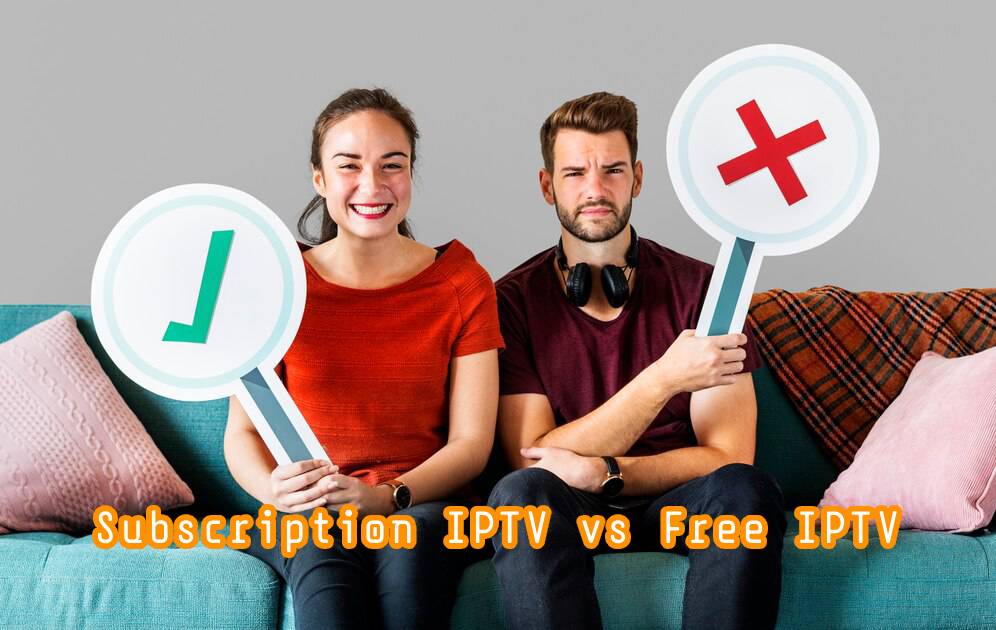As IPTV services grow by 30% to 35% each year worldwide1, viewers face a tough choice. They must decide between paying for TV or using free IPTV. Both choices have their good and bad sides. Kemo IPTV, for instance, has two plans: Free and Premium. The Premium plan gives you lots of channels, sports, and movies2.
When picking between subscription IPTV and free IPTV, it’s key to look at the pros and cons. Paid IPTV, like Kemo IPTV, offers great streaming quality, supports multiple screens, and has many channels. But, it costs money every month2. Free IPTV, on the other hand, might have fewer channels, annoying ads, and lower quality streaming2. Comparing IPTV services can help you make a smart choice.
Table of Contents
ToggleKey Takeaways
- Subscription-based TV and free IPTV have different pros and cons.
- Kemo IPTV offers two subscription plans: Free and Premium, with varying features and pricing2.
- Paid IPTV services offer high-definition streaming, multi-screen support, and a wide range of channels.
- Free IPTV services may have limited channel options, intrusive advertisements, and lower streaming quality2.
- An iptv packages review can help viewers choose the best option for their needs.
- Considering both subscription IPTV vs free IPTV options is essential for making an informed decision.
- IPTV services comparison can help viewers evaluate the benefits and drawbacks of each option.
Understanding IPTV: The Basics of Internet Protocol Television
IPTV services have many benefits. They offer premium channels and high-quality streaming. The technology behind IPTV makes streaming smooth. Now, users can pick from live TV, video on demand, and more4.
What is IPTV Technology?
IPTV uses internet protocol to send TV content to users. It’s changed TV watching, making it more flexible and convenient than cable or satellite TV. With IPTV, you can watch a variety of channels, including sports and entertainment3.
How IPTV is Changing Traditional TV Viewing
IPTV services are changing how we watch TV. Many people now choose paid iptv and free streaming over traditional TV. This is because IPTV is more convenient and offers more channels and content4. As IPTV grows, we’ll see even more new services and features.
Subscription IPTV vs Free IPTV: Key Differences
Free IPTV, on the other hand, has fewer channels and lower quality, often only in Standard Definition (SD)2. It’s a budget-friendly choice for those who want some live TV. When looking for the best iptv provider, consider channels, quality, and price5.
Quality and Reliability Factors in IPTV Services
When looking at iptv services, quality and reliability are key. It’s important to compare the stream quality, server stability, and loading speeds of different iptv providers. Data shows that IPTV services are growing fast, with over a billion subscribers worldwide1.
This growth is because many iptv providers offer high-quality streaming. They provide high-definition video and support for many video formats1.
To solve these problems, many iptv providers invest in strong server infrastructure. They also add features like pause, rewind, and record to make things easier for users1. As the online streaming market grows, iptv providers must focus on quality and reliability to keep up with their subscribers’ needs6.
Cost Analysis: Investment vs. Value

When looking at iptv cost analysis, it’s key to compare the cost of subscription TV and free IPTV. We must also think about the value each offers7. IPTV services have different prices, with basic plans starting at $7.99/month and top-tier plans at $11.99/month7. Resellers can buy packages for $97.99, which includes 5 credits7.
The cost of iptv pricing plans varies widely. Basic channels cost under $10/month, while full channel lineups and premium content can cost over $70/month7. It’s important to look at iptv deals and cheap iptv options. Also, watch out for hidden costs like installation fees or data usage charges7. The global IPTV market is expected to grow fast, with paid services leading in revenue8.
Paid IPTV services usually cost between $10 and $50/month. Free IPTV services, on the other hand, are free with no subscription fees9. Paid services offer better streaming quality, fewer ads, and 24/7 support. This makes them more valuable for many users9. When picking an IPTV service, it’s vital to compare iptv pricing plans and iptv deals to get the best value7.
Content Library and Channel Selection
IPTV services offer a wide range of content, making it easier to find the right provider. Users can pick from many IPTV channel options and packages. This lets them tailor their viewing experience to their liking. The cost of IPTV varies, with some providers offering flexible plans and pay-per-view options10.
Some popular IPTV services have over 110,000 live TV channels and 60,000 VOD options. Prices start at just $13.99 per month11.
IPTV services provide a variety of sports and entertainment, including live events and on-demand content. Users can watch their favorite shows and movies on multiple devices. This includes smartphones, tablets, and PCs, making it easy to enjoy content anywhere, anytime10.
Some IPTV providers also offer exclusive regional content. This is great for users who want to stay connected to their local community11.
Popular IPTV services include GUEKHDIPTV, EVESTV, and Kemo IPTV. Each offers a unique selection of channels, VOD content, and pricing plans11. When choosing an IPTV service, consider stream quality, server stability, and customer support. This ensures a smooth viewing experience. By picking the right IPTV service, users can enjoy a wide range of content at an affordable price10.
Security and Legal Considerations

Using iptv legalities without a license can be risky. About 75% of free IPTV services don’t have the right licenses12. This means users could face legal trouble. It’s crucial to pick a licensed IPTV provider for a safe watch.
Users need to know the risks and protect themselves with IPTV. By picking a trusted provider and focusing on iptv security and iptv legalities, they can enjoy quality streaming tv. This includes premium channels and sports, making it a great choice for a reliable online television experience1213.
Device Compatibility and Technical Support
When picking an IPTV service, think about device compatibility and tech support. Most IPTV services work well with many devices like smartphones, tablets, and smart TVs. They support over 90% of these devices14. Make sure the IPTV devices work with Android, iOS, Windows, macOS, and smart TV systems15.
A good IPTV service should have little buffering, even when lots of people are using it. It should also keep streaming quality steady, even if your internet changes15. You’ll get about 80-100 TV channels and lots of VOD content on different devices14. If you run into problems, a top IPTV service will be up and running almost all the time15.
Using iptv buying and installation guides can help you set up your service right. Many IPTV providers offer free trials. This lets you check if the service works well, streams quality, and has the content you want without spending money15. By looking at these points and picking a trusted IPTV provider, you can have a smooth viewing experience on your favorite devices.
User Experience and Interface Quality
The iptv user experience is key in streaming television. It affects how users enjoy live tv. A well-designed iptv interface greatly improves the viewing experience.
User reviews show that a good interface is easy to navigate. It should have a simple program guide16. This helps users find their favorite channels and shows fast.
Services like Iptvalue and Topstreamiptv offer high-quality streaming up to Full HD. They support multiple devices, enhancing the user experience16. ReflexSat IPTV also ensures 99.9% uptime, providing reliable streaming17. The interface should include features like recording and time-shifting, allowing users to watch shows at their convenience.
Good customer support is crucial for users, helping with setup and troubleshooting16. A user-friendly interface makes it easy to find help when needed. By focusing on these aspects, iptv services can offer a top-notch user experience. This makes streaming television a fun and easy option for live tv fans.
Conclusion: Making the Right Choice for Your Streaming Needs
Choosing between subscription TV and free IPTV services requires careful thought. You must consider quality, reliability, content, and cost18. IPTV, running on managed networks, can reduce buffering by up to 90% and offer a smoother viewing experience18. On the other hand, OTT services provide more flexibility and a broader selection of content. About 60% of users prefer ad-supported models to save on costs18.
If you’re looking for the top IPTV service18, iptvsubscriptionshop.com (IPTV Subscription Shop) is a great choice. They offer high-quality, 4K & HD channels, work with all devices, have 99% uptime, and no freezing18. With the IPTV market set to grow to 1.5 billion users by 202518, picking the right service is key to a great viewing experience.
FAQ
What is the difference between subscription-based TV and free IPTV?
Subscription TV gives you more channels and better quality. It also has extra features. Free IPTV has less content and lower quality. It also might be illegal.
How does IPTV technology work, and how is it changing traditional TV viewing?
IPTV uses the internet to send TV shows. It lets you watch when you want. It’s changing TV by giving viewers more choices.
What are the key differences in terms of cost, available content, and streaming quality between subscription IPTV and free IPTV?
Subscription IPTV costs more but offers better quality and more channels. Free IPTV is cheaper but has less content and lower quality.
How do subscription IPTV and free IPTV services compare in terms of stream quality, server stability, and loading speeds?
Subscription IPTV has better quality and is more reliable. It loads faster, making your viewing smoother.
What is the cost analysis for subscription-based TV and free IPTV, and how do they compare in terms of value?
Subscription TV costs more upfront but offers more value over time. Free IPTV is cheaper but may not be as good.
How do the content libraries and channel selections differ between subscription IPTV and free IPTV?
Subscription IPTV has more channels and better content. Free IPTV has less to choose from.
What are the security and legal considerations when using IPTV services?
Free IPTV can be risky and illegal. Subscription IPTV is safer and legal.
How do IPTV services compare in terms of device compatibility and customer support?
Subscription IPTV works on more devices and has better support. This makes it easier to use.
How do the user interfaces and experience differ between subscription IPTV and free IPTV?
Subscription IPTV has better interfaces and features. Free IPTV is simpler but less user-friendly.


